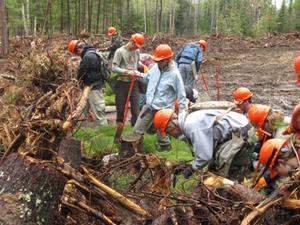Twenty natural resources students from the University of Minnesota, Crookston recently planted some 2,700 pine, spruce, and fir seedlings on the Deer River District of the Chippewa National Forest.
The four-day trip, a strong tradition for students in the Natural Resources Club at the U of M, Crookston, marks the 28th consecutive time student volunteers from the campus have assisted the U.S. Forest Service with the tree planting project. The students were accompanied by club advisors Phil Baird, Tom Feiro, and Laura Bell.
Crookston, marks the 28th consecutive time student volunteers from the campus have assisted the U.S. Forest Service with the tree planting project. The students were accompanied by club advisors Phil Baird, Tom Feiro, and Laura Bell.
Baird, an associate professor in the Agriculture and Natural Resources Department at the U of M, Crookston, said, "This was one of the wettest trips we've had in 28 years! It rained nearly every other hour for the entire time we were there! We've been snowed on, rained on, and hailed on in the past, but not so continuously.
"It was also a very different trip from our previous 27 years in that we saw trees and shrubs in full bloom that have never been at that stage in early May before. It was only two years ago that we had to wrap up the trip early due to the area receiving 20 inches of snow!"
The student volunteers also removed the more than 5,000 budcaps they had installed last October on white pine seedlings and saplings to protect the small trees from overwinter deer browsing. On the return trip the group toured the Minnesota Department of Natural Resources Air Tanker Base in Bemidji, Minn.
Since 1983, students, faculty, and staff from the natural resources program on the Crookston campus have planted a total of more than 165,000 trees in the Chippewa National Forest.
For more information about natural resources, visit www.umcrookston.edu/academics.
Today the University of Minnesota, Crookston delivers more than 25 bachelor's degree programs and 50 concentrations, including several online degrees, in agriculture and natural resources; arts, humanities and social sciences; business; and math, science and technology. With an enrollment of about 1,300 undergraduates, the Crookston campus offers a supportive, close-knit atmosphere that leads to a prestigious University of Minnesota degree. "Small Campus. Big Degree." To learn more, visit www.umcrookston.edu.
The four-day trip, a strong tradition for students in the Natural Resources Club at the U of M,
 Crookston, marks the 28th consecutive time student volunteers from the campus have assisted the U.S. Forest Service with the tree planting project. The students were accompanied by club advisors Phil Baird, Tom Feiro, and Laura Bell.
Crookston, marks the 28th consecutive time student volunteers from the campus have assisted the U.S. Forest Service with the tree planting project. The students were accompanied by club advisors Phil Baird, Tom Feiro, and Laura Bell. Baird, an associate professor in the Agriculture and Natural Resources Department at the U of M, Crookston, said, "This was one of the wettest trips we've had in 28 years! It rained nearly every other hour for the entire time we were there! We've been snowed on, rained on, and hailed on in the past, but not so continuously.
"It was also a very different trip from our previous 27 years in that we saw trees and shrubs in full bloom that have never been at that stage in early May before. It was only two years ago that we had to wrap up the trip early due to the area receiving 20 inches of snow!"
The student volunteers also removed the more than 5,000 budcaps they had installed last October on white pine seedlings and saplings to protect the small trees from overwinter deer browsing. On the return trip the group toured the Minnesota Department of Natural Resources Air Tanker Base in Bemidji, Minn.
Since 1983, students, faculty, and staff from the natural resources program on the Crookston campus have planted a total of more than 165,000 trees in the Chippewa National Forest.
For more information about natural resources, visit www.umcrookston.edu/academics.
Today the University of Minnesota, Crookston delivers more than 25 bachelor's degree programs and 50 concentrations, including several online degrees, in agriculture and natural resources; arts, humanities and social sciences; business; and math, science and technology. With an enrollment of about 1,300 undergraduates, the Crookston campus offers a supportive, close-knit atmosphere that leads to a prestigious University of Minnesota degree. "Small Campus. Big Degree." To learn more, visit www.umcrookston.edu.
Contact: Phil Baird, associate professor, 218-281-8130 (pbaird@umn.edu); Elizabeth Tollefson, assistant director, communications, 218-281-8432 (ltollefs@umn.edu)

